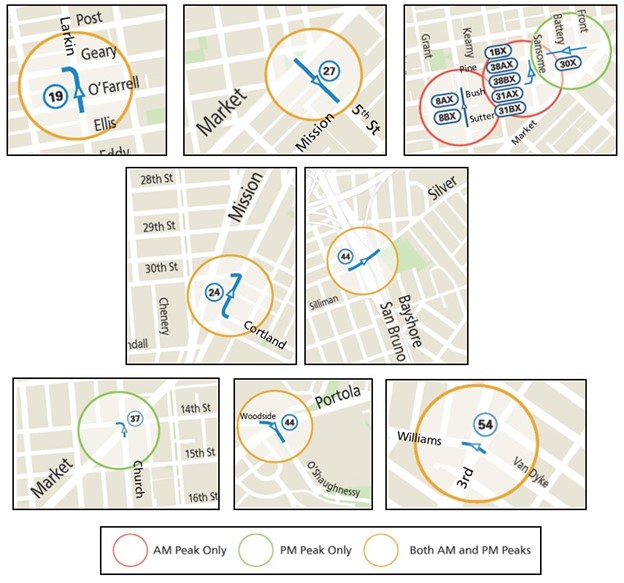By Cassie Halls
The SFMTA has had its fair share of ribbon-cutting ceremonies over the last two years. These celebrations draw attention to some of our biggest projects. Also attention-worthy are some of the more incremental efforts happening at the agency.
One such effort led by the Muni Forward team is the Transit Delay Hot Spots Program, launched in February 2020. Muni Forward is known for corridor projects such as the L Taraval Improvement Project, 16th Street Improvement Project, and M Oceanview Transit and Safety Project. These efforts are increasing the already sizeable 80 miles of transit reliability upgrades since 2014. There are also other ways we’re working to slash travel times and improve reliability across the Muni network.
The Transit Delay Hot Spots Program aims to tackle the 10 worst “delay hot spots” each year, where buses crawl between stops at four miles an hour or less. We’re looking closely at the causes of delay at these hot spots, whether it’s a lengthy traffic signal, clogged curb or difficult turn. And results have been promising so far – with travel time savings of up to 50%.
We identified the slowest segments of the Muni network to improve travel time, whether on the highest ridership routes or less ridden but essential connector routes. This also helps us to support the Muni Service Equity Strategy. The Muni Service Equity Strategy aims to make measurable improvements to safety, connectivity to key destinations, reliability, frequency and crowding.
The hot spots fall on routes such as the 44 O’Shaughnessy, 8AX/BX Bayshore Express and 24 Divisadero. So far, we’ve noticed some patterns of what causes the most delay. Common causes of Muni delays include very close stop spacing (where stops are on both sides of the same intersection), tricky turns, traffic and curb space issues. We address these delays with a toolkit of priority treatments.

Maps of Current Transit Delay Hot Spot locations
The preliminary results of the program have been promising:
- 54 Felton: Removing a nearside stop shortened travel times by 50%.
- 8AX/8BX Bayshore Express: The NoMa/SoMa Signal Retiming Project cut pre-pandemic travel time by 20-25 seconds or around 22% and travel times have improved further with less congestion downtown.
- 27 Bryant: The line was rerouted in SoMa to take advantage of transit lanes on 7th and 8th streets that were installed through the Temporary Emergency Transit Lanes program.
You can read more about each of the hot spots on the Transit Delay Hot Spots program page. We will continue to track performance and community feedback and will make changes if needed.
We will be making improvements at three more hot spots over the next few months (two locations along the 44 O’Shaughnessy and one location on the 19 Polk). Each year, we will run the numbers on the 10 worst hot spots, install improvements and measure results. Stay tuned for more updates on our current hotspot program and our 2023 hotspot locations!
Published October 12, 2022 at 02:14AM
https://ift.tt/OoFM6Nz
Comments
Post a Comment